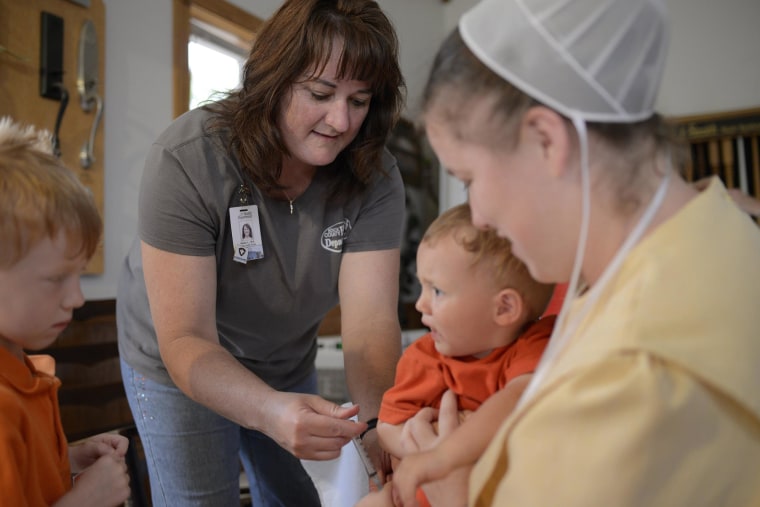An outbreak of measles that started in California’s Disneyland probably came from overseas, carried either by a foreign tourist or by an American coming back with the virus, a top federal health official said Thursday.
The virus has now infected 94 people in eight states, and 67 can be clearly linked to Disneyland, California health officials report. Because measles is so contagious, more cases can be expected.
“We don’t know exactly how this outbreak started but we do think it was likely a person infected with measles overseas,” Dr. Anne Schuchat of the Centers for Disease Control and Prevention told reporters.
“We assume that someone got infected with measles overseas, visited Disneyland park, and spread the disease to others.”
“This is a wake-up call to make sure that we keep measles from regaining a foothold in our country."
There’s been on ongoing outbreak of measles in the Philippines, but no imported U.S. cases have been linked to the Philippines this year, Schuchat said. Genetic tests of the virus affecting Americans are similar to strains seen in Indonesia, Qatar, Azerbaijan and Dubai.
Whoever first brought the virus to Disneyland is probably long gone, Schuchat said, and could even be unaware that he or she caused the outbreak.
“This is a wake-up call to make sure that we keep measles from regaining a foothold in our country,” Schuchat said.
“France went from about 40 cases a year to over 10,000 cases. It is only January and we have already had over 84 cases.”
France reported 10,000 cases of measles in 2000. Like other countries, the numbers vary greatly from one year to another, and in 2011 France reported nearly 15,000 measles cases but that fell to just 272 cases in 2013.
No matter what the source, doctors and nurses need to be on the lookout for the highly infectious virus, she warned.
“We are urging all health care professionals to think measles during medical visits,” Schuchat said. Anyone with a fever, especially if there’s a rash, should be evaluated for measles. It’s the most infectious virus known, with a 90 percent transmission rate among people who are not immunized or otherwise immune to it. Each patient with measles can infect 12 to 18 other people."
The reason it’s spreading is simple. People have failed to get vaccinated, Schuchat said.
“This is not a problem of the measles vaccine not working. It’s a problem of the measles vaccine not being used,” she said. “Measles can be a very serious disease and people need to be vaccinated.”
Most Americans have been vaccinated but some cannot get the vaccine for medical reasons — if they have a damaged or compromised immune system, for instance. Babies under a year old are not vaccinated because their bodies don’t really respond well to the vaccine and it doesn’t protect them.
But the biggest problem is people who skip vaccines for philosophical reasons, said Schuchat.
“It is frustrating that some people have opted out of vaccination,” she said. “I think we do have some communities with many who have not received vaccines.”
Measles was eliminated in the U.S. in 2000, but a few imported cases come in every year.
“Measles can come into our country easily through visitors or when Americans travel abroad and bring it back,” Schuchat said.
“Measles is still common around the world and we estimate there are around 20 million cases a year,” Schuchat added. Of them, more than 145,000 die every year. “For every 1,000 children who get measles, one to three of them die despite treatment,” Schuchat said. And 28 percent of kids who get measles are sick enough to be hospitalized, and can suffer permanent brain damage.
Last year, a big outbreak was traced to Amish volunteers who went to help after a typhoon in the Philippines and who got infected during a measles outbreak there. It helped make for a record year in the U.S. with 600 cases.
What CDC wants to avert is something like what happened between 1989 and 1991, when 55,000 people got measles and 123 died.
Most of the kids made sick in the Disney outbreak had not been vaccinated, Schuchat said. But more adults than usual have been infected.
“There’s no harm in getting another MMR vaccine.”
This might not mean much. The vaccine isn’t 100 percent effective and most U.S. kids are vaccinated. That means the vulnerable people are more likely to be adults, just by virtue of the fact that adults travel more and there are more adults than children in the United States.
Schuchat says it’s impossible to predict how bad the outbreak will get and where new cases will emerge.
“I think people really need to know that you can get measles anywhere. It’s invisible and we have importations every year,” she said.
But she says CDC is not especially worried about the upcoming Super Bowl in Arizona on Sunday. Schuchat doubts an unusual number of unvaccinated people will be traveling to the Super Bowl and measles only spreads to people who are not immune.
But the non-immunized need to take care.
“You can catch measles just by being in the same room as a person who has measles,” she said.
“If you are not sure whether you have had the measles vaccine or not … contact your doctor or nurse,” she advised.
“There’s no harm in getting another MMR vaccine.”
